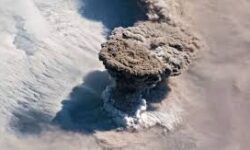What Did Your Address Look Like 250 Million Years Ago?
What Did Your Address Look Like 250 Million Years Ago?
Do you remember how we all in childhood asked ourselves the question: if from this very place where we are standing, dig a tunnel through the Earth, then in what part of the world will we find ourselves? And in which country? For some reason, the most common options were China and Africa.
Scientists have discovered a lot of clues, but the final verdict makes it wait. So far, only that on land and at sea serious changes have been firmly established. The level of oxygen in the ocean has gone down, and it has become difficult for many organisms to live. On the contrary, the content of carbon dioxide and methane was unusually high, a strong global warming unfolded. There were acid rains, and coral reefs dissolved in the seas. The earth turned into a sultry dry desert, the remains of vegetation died as a result of fires. The climate abruptly shied away one way or the other, and many species did not have time to adapt to the changes.
At about the same time, two giant volcanoes erupted in the south of China (260 million years ago) and in northern
Russia (251 million years ago). Obviously, this led to the release of huge
amounts of carbon dioxide into the atmosphere and, consequently, to the greenhouse
effect and global warming, as well as to the acidification of the ocean, which
killed many organisms. Recent modeling has shown that in the Northern
Hemisphere, the pH of rain has reached 2.0, the index of lemon juice. At the
same time, a catastrophic amount of methane — another powerful greenhouse gas —
was released.
Some scientists believe that the drama began to unfold even before this. The sharp drop in sea level could not but shuffle the sea currents and the wind rose, the result of which was also to be climate change.
Members of the Chinese University of Earth Sciences Yin Hongfu and Song Haijun offer their answer. In their opinion, everything began to move for 50 million years before the climax.
Approximately 300 million years ago, at the beginning of the Permian period, the entire land of the planet gathered in a single supercontinent Pangea, and all the seas of the Earth formed the global ocean of Pantalass.
The formation of Pangea led to the fact that the mountains became higher, and the ocean – deeper. According to the principle of equilibrium, the giant continent should have a thicker crust compared with scattered continents, and the ocean
The hinterland of the gigantic continent has dried up, turning into a desert devoid of vegetation.
In addition to this, deep underground, it was also restless. When the lithospheric plates joined, some went under the others and plunged into the mantle. This material, since it was relatively cold and dense, could reach the core itself, as evidenced by the inversion of the Earth’s magnetic field (Illawarra’s geomagnetic inversion) that occurred at about the same time.
The accumulation of cold material near the Earth’s core could then lead to the formation of a large mantle plume (by means of thermal convection). This superplume eventually reached the surface in two steps, which led to the eruption of two giant volcanoes.
Software developer Ian Webster created an interactive map on dinosaurpictures.org, which shows how the Earth has changed over the past 750 million years, as the movement of tectonic plates has changed the shape of
Webster has built a visualization of the data based on information gathered by geologists who have investigated tectonic plates. The developer indicates that, of course, the map determines the locations approximately. But still watching how the planet changed, for example, during the split of the supercontinent Pangea about 175 million years ago, is simply amazing.
For those who are interested not only in the picture, Webster added a brief description of what was happening with the planet in a given time period.
So, 750 million years ago, Moscow (pink dot), as you see, would be in the ocean. “Cryogenic period. Glaciers cover almost the entire Earth during one of the most significant ice ages in the history of the planet. Single-celled organisms appear, such as green algae.” 240 million years ago.
“The beginning of the Triassic period. The level of oxygen is much lower due to the extinction of many plants on land. Ancestors of birds, mammals, dinosaurs appeared. ” 220 million years ago.
“Middle Triassic period. Earth is recovering after the Perm catastrophe. Small dinosaurs appear. There appeared therapeutics (bestial), archeosaurs, and the first flying invertebrates. ” 170 million years ago. “Jurassic period. Dinosaurs are safely born and developed, the first mammals and birds appear. Life in the ocean is diverse. There is a warm climate on Earth. ” 35 million years ago, the appearance of the first primates.
“The average tertiary period. Mammals are transformed from a small, simplest form into a heterogeneous group. Primates, cetaceans and other groups develop. The land is cooling, and deciduous plants are becoming more common. ” An interactive map has been created that shows where you can be by digging a tunnel through the Earth.
The Antipodes Map website has created an interactive map that will show where you will find yourself if you start digging the earth to get to the fiery core of the planet and come out from the opposite end. First you need to enter the address or city from which you would like to start the journey. Then the map with Google will show where you will be. True, if you plan to start diving somewhere in Europe, then be prepared for the fact that you get wet, because, most likely, you will come out somewhere in the middle of the ocean. According to the creators of the site, most locations located on the ground do not have an antipode on land.
The antipode is a point on the earth’s surface, diametrically opposed to this one. The simplest antipodes are the North and South Poles. St. Petersburg – somewhere in the middle of the Southern Ocean.
- Novosibirsk – the Southern
- Ocean, somewhere off the coast of Argentina.
- Krasnodar – the South
- Pacific.
- Ekaterinburg – South Ocean.
- Kiev is the South Pacific.
- Ulan-Ude – Chile.
- Haibowan, China – Chile.
- Padang, Indonesia, – Ecuador.
- Hong Kong – Argentina.
- Buenos Aires – somewhere in the waters of South Korea.
- Moscow – the Southern Ocean.



